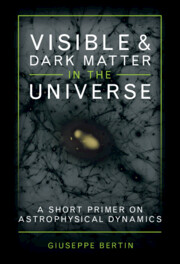Book contents
- Frontmatter
- Dedication
- Contents
- Preface
- Acknowledgements
- Part I Visible Matter
- 1 Light
- 2 Optical Astronomy
- 3 Radio Astronomy
- 4 X-Ray and Gamma Ray Astronomy
- 5 Astroparticle Physics, Gravitational Waves, and Space Physics
- Part II Dark Matter
- 6 Galaxies
- 7 The Supermassive Black Hole at the Center of the Milky Way
- 8 Two Precursors of the Problem of Dark Matter
- 9 The Discovery of Dark Halos around Spiral Galaxies
- 10 The Cosmological Context
- Index
8 - Two Precursors of the Problem of Dark Matter
Published online by Cambridge University Press: 08 December 2022
- Frontmatter
- Dedication
- Contents
- Preface
- Acknowledgements
- Part I Visible Matter
- 1 Light
- 2 Optical Astronomy
- 3 Radio Astronomy
- 4 X-Ray and Gamma Ray Astronomy
- 5 Astroparticle Physics, Gravitational Waves, and Space Physics
- Part II Dark Matter
- 6 Galaxies
- 7 The Supermassive Black Hole at the Center of the Milky Way
- 8 Two Precursors of the Problem of Dark Matter
- 9 The Discovery of Dark Halos around Spiral Galaxies
- 10 The Cosmological Context
- Index
Summary
This chapter describes two problems initially studied in the 1930s, a few years
after the discovery of galaxies. In later years, they were revisited and, a posteriori,
appeared to be important precursors of the problem of dark matter, which
in the meantime had emerged clearly from the study of the rotation curves of
spiral galaxies. In reality, the early studies of clusters of galaxies
and of the vertical dynamics of the solar neighborhood had failed to provide
decisive evidence for the existence of dark matter. In fact, for both cases significant
confusion remained until the end of last century. Then, with the advent
of fresh data from the Hipparcos mission, it was proved that from the vertical
dynamics of the solar neighborhood there is no evidence for the presence
of dark matter in the disk. In turn, with the combined use of improved X-ray
observations and of gravitational lensing clusters of galaxies were eventually
shown to be associated with large amounts of dark matter, which, in contrast to the case of galaxy halos, appears to be more concentrated with respect to the distribution of visible matter. The closing dynamical section describes the properties of the self-gravitating slab model, often used to describe the local properties of galaxy disks.
Keywords
- Type
- Chapter
- Information
- Visible and Dark Matter in the UniverseA Short Primer on Astrophysical Dynamics, pp. 119 - 131Publisher: Cambridge University PressPrint publication year: 2022

